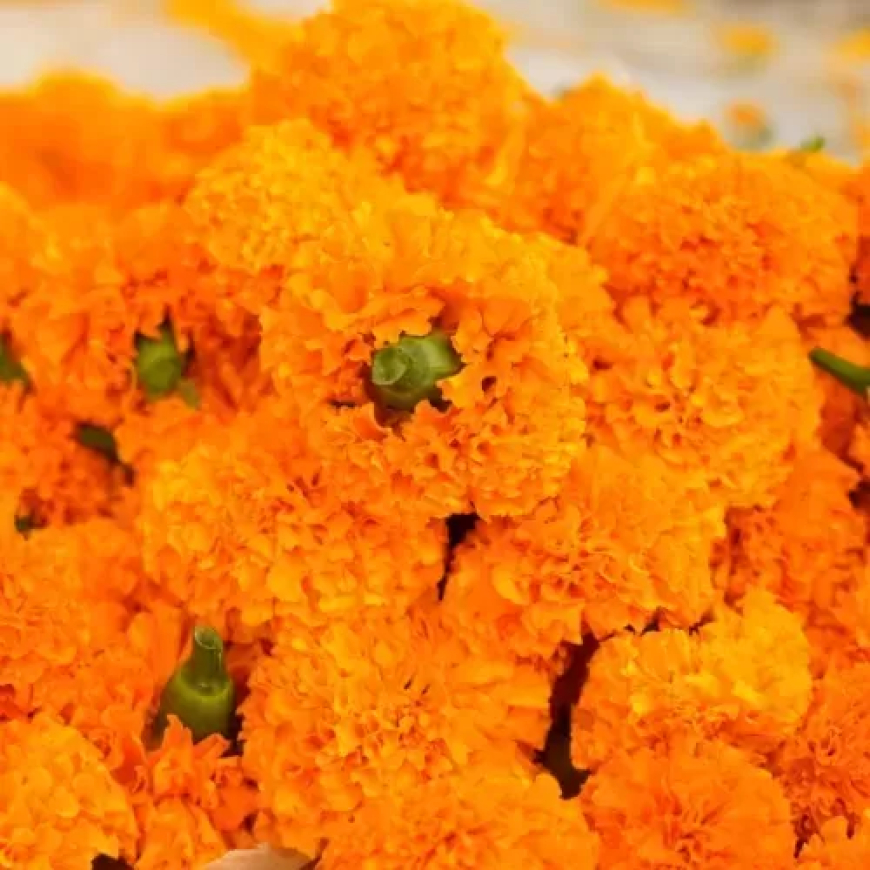The Timeless Beauty of Marigold Garlands: A Symbol of Culture, Tradition, and Celebration
Marigold garlands are considered an integral part of long histories and cultures and associated with many different practices. As they are bright in color and intense in fragrance, they appear not only beautiful to see but also symbolic, as they go back several centuries, especially in countries like India, Mexico, and many parts of Southeast Asia. Whether used during weddings, religious ceremonies, or festive celebrations, a marigold garland signifies pure joy and beauty. Let us turn the page and discover the rich meanings of marigolds, how they are used, and why they are treasured up to date.

Marigold garlands are considered an integral part of long histories and cultures and associated with many different practices. As they are bright in color and intense in fragrance, they appear not only beautiful to see but also symbolic, as they go back several centuries, especially in countries like India, Mexico, and many parts of Southeast Asia. Whether used during weddings, religious ceremonies, or festive celebrations, a marigold garland signifies pure joy and beauty. Let us turn the page and discover the rich meanings of marigolds, how they are used, and why they are treasured up to date.
The Marigold: A Flower of Significance
Marigolds. These bright orange and yellow flowers represent more than their beauty, as they contain the voices of many culture and traditions. This flower represents warmth and positivity by its color because it can be compared to the sun; however, they are said to carry warmth and positivity wherever they are placed.
The marigold is considered a sacred flower in India. Its name in Hindi, "Genda," is used to describe auspicious occasions. Marigolds are usually offered to deities during religious worship, used in garlands for temples, weddings, and several festivals. They symbolize new beginnings, purity, and the power of the divine. The color that marigolds are renowned for also repels evil spirits, which is why they are often used in Hindu rituals.
In Mexico, marigolds are used as part of the Día de los Muertos, or Day of the Dead, where they pay homage to someone who has died. There, the marigold leaves are simply known as "Flor de Muerto," or Flower of the Dead, to enable the spirits to go back into the world of the living. These flowers with their bright warm colors and strong fragrance draw the spirits of the dead.
Marigold Garlands Features in Cultural and Religious Functions
Marigold garlands are highly featured in the region of South Asia as a part of cultural and religious functions. In India, marigold garlands are very common during wedding celebrations, festivals, and housewarmings. They are draped over idols, hung at doorways or kept on altars. Love, honor, and respect aspects embodied in garlands make them an integral part of all the major events in people's lives.
Marigold garlands are widely used during the "Jaimala" or "Varmala" ceremony of Indian marriages, where the bride and groom hand garlands to each other to symbolize acceptance of each other in matrimony. Such an ancient custom reflects commitment and mutual respect between the couple.
Garlands of marigold flowers are easily available during the Diwali and Durga Puja celebrations that decorate homes and temples. Their bright hues signifying victory for light over darkness become a great representation of the festivities during the season. Marigold garlands are worn on doors and windows to invite good luck and guard the premise against evil forces.
The Art of Marigold Garlands: A Traditional Tradition
Making a marigold garland is an art that requires patience and an eye for beauty. To start with, one needs to get hold of fresh marigolds with strong stems and vibrant petals. Then they string the flowers together using needle and thread, creating patterns not too uniform depending on the celebration. Some garlands are just a simple chain of marigolds, and some have additional flowers that add fragrance and contrast to the palette of colors.
While fresh marigold garlands continue to prefer traditional events, the highly prepared artificially made garlands are often in use these days because they possess a longer shelf life and are easier to handle. Still, nothing surpasses the charm of fresh marigolds-be it for the fragrance they own or the goodness related with them.
Marigold Garlands in Modern Decor
Although marigold garlands have long-standing cultural meaning, they seem to have been incorporated into the current décor and planning of events. Nowadays, marigold garlands are used in most wedding ceremonies, not only for religious purposes but even as an ornate décor for venues themselves since the bright colors really work well behind vibrant backdrops, making a great arched floral framework, or a hanging garden.
Similarly, Marigold garlands have turned out to be another cross-cultural phenomenon. It is not limited to religious events, but transcends to secular events also, like fashion and photography shoots, as well as western wedding celebrations of those couples who like to inject some culture or bohemianism in their nuptials. Marigold garlands speak to everyone because it is a symbol for positivity and festivity.
Conclusion: A Tradition That Continues to Bloom
More than just beauty created from flowers, garlands are an epitome of the richness of cultural heritage and tradition. Whether it is a religious ritual or a wedding or a celebratory occasion, the garlands hold a deeper meaning that interlinks people with their roots, their beliefs, and their emotions. With changing times, beauty such as this is not threatened by it; instead, it remains pure, celebrative, and warm.
The marigold with its splendor of brightness and illumination will forever be part of those ceremonies that honor both life and death, and the garlands made from them will continue to be woven in the most treasure
What's Your Reaction?
 Like
0
Like
0
 Dislike
0
Dislike
0
 Love
0
Love
0
 Funny
0
Funny
0
 Angry
0
Angry
0
 Sad
0
Sad
0
 Wow
0
Wow
0









































































































